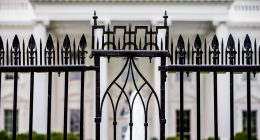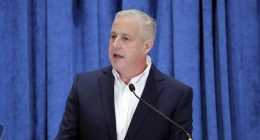
WASHINGTON—The U.S. plans to launch new trade talks with China, but will maintain tariffs on Chinese imports as it presses Beijing to fulfill pledges to buy more U.S. goods and services.
The new initiative was detailed in a policy address Monday by U.S. Trade Representative Katherine Tai, in her first detailed remarks on trade between the world’s two largest economies since she took office in March.
Ms. Tai said that the U.S. will reopen a process for U.S. companies to seek exemptions from tariffs. The Trump administration created an exclusion process for companies that could show they had no viable alternative to Chinese imports, but the Biden administration allowed that process to expire.
The Biden administration has spent months reviewing China policy, including the tariffs imposed by the Trump administration that initially taxed about $370 billion in Chinese imports, including consumer goods like electronics, apparel and furniture, as well as thousands of items that are part of the supply chain for many U.S. factories.
In a briefing on the issue Sunday, Biden administration officials said they planned to keep the tariffs in place—and consider imposing additional levies—as leverage to get China to fulfill terms of the 2020 trade deal with the U.S.
Following her speech Monday at the Center for Strategic and International Studies in Washington, Ms. Tai was asked if she was considering future investigations into Chinese trade practices, like the Trump administration did, to impose additional tariffs.
Ms. Tai said that would depend on China’s response to renewed engagement, but said such investigations are “a very, very important tool. We will look at all available tools.” She declined to say whether the administration would consider new tariffs without launching a new trade investigation first.
A senior administration official said before her speech that “we do not want to take any options off the table or pre-emptively box ourselves into a set course of action.”
A centerpiece of the trade deal was Beijing’s promise to boost its purchases of U.S. agriculture, energy products and manufactured goods. The pact called for China to increase purchases of goods and services by an extra $200 billion over the course of 2020 and 2021.
China missed the goal for goods purchases by nearly 40% in 2020, according to calculations from Chad Bown, a senior fellow at the Peterson Institute for International Economics who has been tracking the effort. As of data for the first 8 months of the year, China is on pace to be 30% short of its goal in 2021.
In May, Ms. Tai and China’s Vice Premier Liu He, who served as China’s lead trade negotiator during the U.S.-China trade war, had a call that was described as an introductory virtual meeting. Both sides described that discussion as candid, and Chinese officials reiterated a call for the U.S. to roll back remaining tariffs on Chinese products.
Since then, Ms. Tai hasn’t engaged directly with top Chinese trade officials.
Business groups have been pushing the Biden administration to move more quickly, citing the importance of China’s huge consumer market to U.S. companies.
“We’re pleased the administration is taking a step forward by articulating its China strategy,” said Myron Brilliant, executive vice president and head of international affairs at the U.S. Chamber of Commerce. “Engagement with allies is important, but it can’t just be engagement with allies. Direct engagement with China is essential.”
In her speech, Ms. Tai emphasized that China’s trade practices hurt U.S. workers and industries.
“We will use the full range of tools we have and develop new tools as needed to defend American economic interests from harmful policies and practices,” Ms. Tai said. The Biden administration will also “work with allies to shape the rules for fair trade in the 21st century, and facilitate a race to the top for market economies and democracies.”
The Chinese embassy in Washington didn’t respond to a request for comment.
The renewed attempt to engage on trade follows a call last month between President Biden and President Xi Jinping that was designed in part to maintain lines of communication as tensions between the two countries have grown since Mr. Biden took office. Mr. Biden has said the nations should compete but also look to cooperate on issues such as climate change.
The Biden administration has taken a number of steps that have angered Beijing, including sanctioning officials over the repression of mainly Muslim Uyghurs in China’s northwestern Xinjiang region and expanding a Trump-era ban on Americans investing in Chinese companies with purported links to China’s military.
The U.S. has also looked to rally allies in confronting Beijing, a goal that has received a mixed reception. One objective has been to shore up supply chains to rely less on China and to better deal with severe shortages during the Covid-19 pandemic.
Mr. Biden also recently convened an in-person meeting of the Quadrilateral Security Dialogue, a partnership with the U.S., Australia, Japan and India focused on security in the Indo-Pacific and countering an increasingly assertive China. Beijing has described such efforts as a Cold War mentality.
The Biden administration has also worked to reset trade relations with the European Union, which were strained by the imposition of tariffs on steel and aluminum and as part of a long-running dispute between the U.S. and Europe over subsidies for aircraft manufacturers.
The U.S. and EU called off their tariffs in the aircraft dispute over the summer, agreed to resolve their steel and aluminum tariff dispute, and met at a summit in Pittsburgh last week to discuss collaboration on a range of trade and technology issues.
The Chinese import tariffs have been a sore spot for many U.S. companies who say they have few alternatives to Chinese parts. That left many companies in a situation where they were forced to pay tariffs but their Chinese competitors weren’t.
When the Trump administration signed its deal with China in January 2020, it was referred to as a “phase one” trade deal, with the implication that negotiations would soon begin on a second phase. Senior Biden administration officials, however, said that while they intend to press China on issues that were left out of that deal, they doubt China will be willing to consider serious negotiations over a second phase.
Write to Josh Zumbrun at [email protected] and Alex Leary at [email protected]
Copyright ©2021 Dow Jones & Company, Inc. All Rights Reserved. 87990cbe856818d5eddac44c7b1cdeb8
This post first appeared on wsj.com









